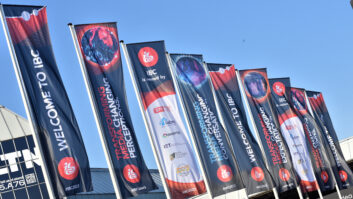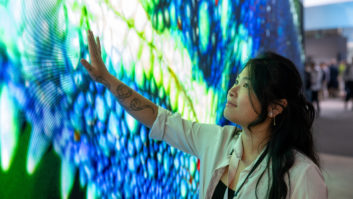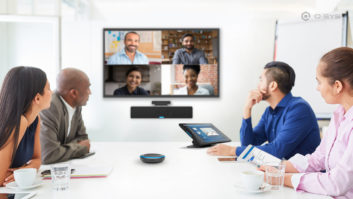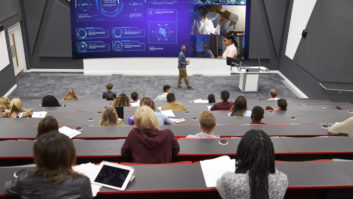New technology has the potential to bring together once disparate business sectors by providing a common infrastructure. IP and DSP have done that for networking and equipment such as mixing consoles in both the live/installed sound sector and broadcasting. This now extends to intercom and while there is again some crossover with broadcast, performance and AV sound continues to have very distinct requirements when it comes to the crucial area of communications.
Of the leading intercom manufacturers, Clear-Com has its roots firmly in live performance, going back to the 1960s music scene in San Francisco. From that starting point it moved into theatre, permanent installations and touring productions. Product manager Kari Eythorsson observes that part of the role of communications, taking theatre and corporate presentations as examples, is “to make people look good”.
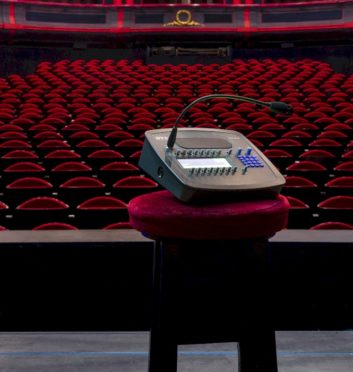 This is achieved by connecting the production and technical teams so that equipment and people are where they need to be and everything happens at the right time. With live events curtailed during the Covid pandemic, the same principles have been applied to video conferencing. “It has to look professional, it can’t just be a Zoom call,” explains Eythorsson. “The corporate event sector is realising that it has the capability to work in a hybrid way, both in a room and remotely. That adds the need for another level of communications, so the stage manager can, for example, cue the talent. It’s still very much a production and there is more need for intercom than ever before.”
This is achieved by connecting the production and technical teams so that equipment and people are where they need to be and everything happens at the right time. With live events curtailed during the Covid pandemic, the same principles have been applied to video conferencing. “It has to look professional, it can’t just be a Zoom call,” explains Eythorsson. “The corporate event sector is realising that it has the capability to work in a hybrid way, both in a room and remotely. That adds the need for another level of communications, so the stage manager can, for example, cue the talent. It’s still very much a production and there is more need for intercom than ever before.”
BROADCAST CENTRIC
This new market is also being targeted by a more broadcast-centric company, The Telos Alliance. It produced one of the early IP intercoms, the Infinity, which, says vice president of business development for TV Martin Dyster, was designed to have a traditional comms look and feel, including multi-key panels. “We’ve talked to people who use Zoom in non-broadcast applications and they still need to be able to run intercom as a private communications channel on top of a call,” he comments.
Telos is best known for broadcast technology, particularly the Axia brand of audio over IP (AoIP) consoles, but, says Dyster, the fact that Infinity has been exhibited at ISE and InfoComm in recent years shows a crossover with AV. “We have a better understanding [of a project] if we’re talking to someone fitting out a theatre or a house of worship, it’s pretty easy to understand what the requirements will be,” he says. “It’s not too far divorced from broadcast or live sound. But if it’s a business that needs to link their factories or different territories for an industrial application, that is very different indeed.”
PERFORMANCE ORIENTED
Over the last 30 years several performance-installation oriented intercom companies have disappeared from the market. The most recent example of this is ASL Intercom, which was bought by Riedel Communications in 2016. From a UK perspective at least, the focus of the parent group remains predominantly broadcast, although the company says non-broadcast, such as corporate, theatre and AV installations, is “trending” more frequently. “I would say we are probably 75 percent broadcast and 25 percent non-broadcast,” says UK sales manager Nacho Lee. “Theatres, performance art centres and other venues all use comms, which could be traditional wired systems or radio walkie-talkies. However, more collaboration across divisions during production requires more sophisticated and better comms, hence people looking into broadcast quality equipment.”
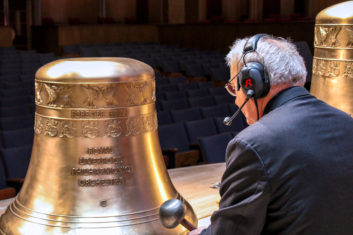 An example of this is the recent installation at Liverpool Philharmonic Hall of Riedel’s Bolero Standalone wireless intercom system, which replaces an existing wired set-up. This covers both the art deco main auditorium and the smaller Music Room and is used to manage and cue concerts, live events, recording sessions and film shoots. Lee says wireless systems such as Bolero can be used by executive level staff – including directors and directors of photography – while other personnel operate on wired performance level (PL) technology or walkie-talkies. “We can easily integrate all these together with the Bolero Standalone and the system will just keep scaling up when it needs to,” he says.
An example of this is the recent installation at Liverpool Philharmonic Hall of Riedel’s Bolero Standalone wireless intercom system, which replaces an existing wired set-up. This covers both the art deco main auditorium and the smaller Music Room and is used to manage and cue concerts, live events, recording sessions and film shoots. Lee says wireless systems such as Bolero can be used by executive level staff – including directors and directors of photography – while other personnel operate on wired performance level (PL) technology or walkie-talkies. “We can easily integrate all these together with the Bolero Standalone and the system will just keep scaling up when it needs to,” he says.
Pliant Technologies is a specialist in wireless intercom and works on houses of worship, theatre and other auditoria, in addition to big installations in the NFL, typically interfacing with older wired networks. “The clock has run down on using older systems,” says vice president of global sales Gary Rosen. “We’ve also had a pause in our lives [due to the pandemic] and many operators took time to refurbish their facilities and upgrade equipment. People are recognising a need to shift towards wireless because everyone now is used to being connected without a wire.”
The Pliant CrewCom for large installations, the smaller-scale, duplex MicroCom and the new CrewCom CB2 systems run in the ISM (industrial, scientific, medical) band of the RF spectrum and, in Rosen’s words, “play nicely with others”. He adds that since Covid, many people still prefer to have some distance between themselves and their colleagues backstage: “Before, it was acceptable to whisper in someone’s ear but now they can whisper from 100 feet away using intercom.”
COVID IMPACT
The pandemic has seriously affected the live performance sector, with venues closed for long periods and many freelancers forced to find work elsewhere. Nico Lewis, senior sales manager for EMEA at RTS Intercoms, comments that theatre was approximately 30 percent of the company’s business but it has been on hold until recently. However, he says other areas have provided alternative opportunities: “We have been really successful in cruise ships, which are floating theatres and take a few years to build.”
 The long lead times in land-based construction has also keep the intercom sector going, with many theatre and venue projects continuing – albeit fitfully – during the pandemic. In terms of technology, Lewis observes that theatres are “in pole position” for AoIP. RTS systems employ OMNEO network technology; this is based on OCA (open control architecture), which forms the basis of the AES70 standard for device control. “This is transparent for Dante [AoIP protocol] and is very popular in theatre where people want to move on from old-fashioned party line systems to a matrix solution.”
The long lead times in land-based construction has also keep the intercom sector going, with many theatre and venue projects continuing – albeit fitfully – during the pandemic. In terms of technology, Lewis observes that theatres are “in pole position” for AoIP. RTS systems employ OMNEO network technology; this is based on OCA (open control architecture), which forms the basis of the AES70 standard for device control. “This is transparent for Dante [AoIP protocol] and is very popular in theatre where people want to move on from old-fashioned party line systems to a matrix solution.”
The position of the intercom matrix is a subject of debate in the intercom world. New AoIP comms systems due not rely on a central hub, which is seen by their proponents as an advantage. Among these is Glensound, which comes from a broadcast background and produces the Beatrice Dante network intercom. Managing director Marc Wilson comments that this product is finding a place in live theatre, typically smaller venues. “IP is flexible and has an ease of installation,” he says. “People get all the benefits of network routing but the connection is simple to set up. Because it’s Dante, it is point to multipoint, as well as point to point, and goes down a single cable with no need for separate power.”
PERFORMANCE TRACTION
AEQ is another broadcast specialist that has developed an AoIP intercom – again Dante with capability for the AES67 interoperability standard – which is finding some traction in the performance sector. Sales director Gustavo Robles estimates that around 15 percent of AEQ’s intercom projects are now for sport or esport arenas and theatres. “They like the audio quality and modularity,” he says. “We still produce systems with analogue or digital audio connections but mainly our customers in broadcast request IP. It is easier to install, configure and operate. Our party line was IP-based from the beginning, so we continue that tradition today.”
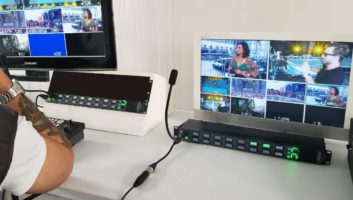 Other IP intercoms include the Unity system, which is aimed at live productions, local events and esports as well as news and sports broadcasting, and the Green-GO range. An early adopter of the latter was UK sound design and event technology company Audio Alliance. Managing director Oliver Driver explains that the firm, which works on high-end live productions and has also moved into broadcast, had been looking for an IP system and eventually found Green-GO. “Communications has been undervalued but it is the glue that holds everything together,” he says. “Green-GO works on its own layer 3 AoIP network but can fit alongside Dante through AES67 interfaces. There is also the option of using DSP to make the system do what you want it to do. Live is less structured than broadcast and needs the flexibility of being able to run one channel or a worldwide conference.”
Other IP intercoms include the Unity system, which is aimed at live productions, local events and esports as well as news and sports broadcasting, and the Green-GO range. An early adopter of the latter was UK sound design and event technology company Audio Alliance. Managing director Oliver Driver explains that the firm, which works on high-end live productions and has also moved into broadcast, had been looking for an IP system and eventually found Green-GO. “Communications has been undervalued but it is the glue that holds everything together,” he says. “Green-GO works on its own layer 3 AoIP network but can fit alongside Dante through AES67 interfaces. There is also the option of using DSP to make the system do what you want it to do. Live is less structured than broadcast and needs the flexibility of being able to run one channel or a worldwide conference.”
Even with the predominance of IP in the AV sector generally, there does not seem to be the view that it will supersede matrices or party lines in the intercom world. Clear-Com’s Kari Eythorsson observes that the different techniques are likely to coexist for sometime and allow users to select what is best for the job: “The question is really ‘What do you need for your production?’ Is it a matrix or a router or a mobile app like Agent-IC using IP?”
And as Nico Lewis at RTS concludes, the most important thing is that communications are always available and they work.
